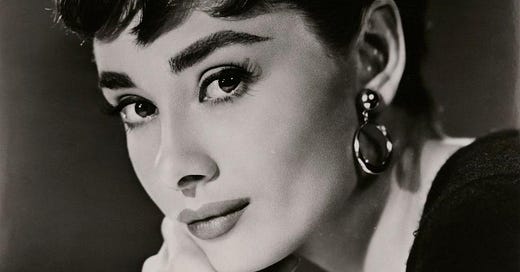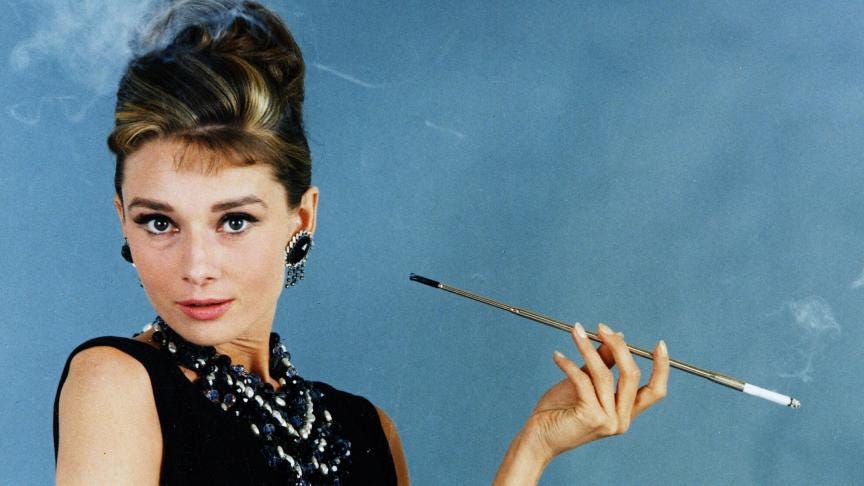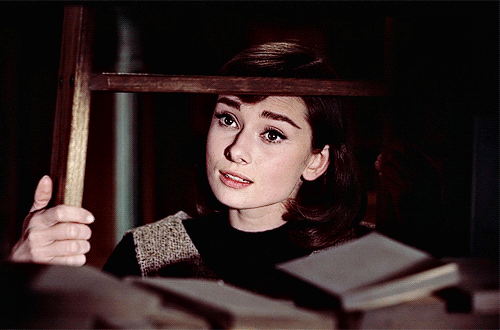(Bud Fraker)
Much like Marilyn Monroe, Grace Kelly and Pattie Boyd, Audrey Hepburn is a female pop culture icon who does not need an introduction. Save for maybe Elizabeth Taylor, there is no dark-haired beauty in film history more photographed, profiled and beloved. Audrey’s classic romantic comedy, Blake Edwards’ Breakfast at Tiffany’s (1961), has long been a common gateway for young girls to discover both old Hollywood and vintage fashion. I regularly viewed both Tiffany’s and George Cukor’s 1964 film adaptation of Alan Jay Lerner & Frederick Loewe’s musical My Fair Lady as a little kid. In middle school and high school, I caught more of her romcom classics, such as Billy Wilder’s Sabrina (1954) and Love in the Afternoon (1957), and Stanley Donen’s Funny Face (1957), Charade (1963) and Two for the Road (1967). Color me more impressed when I later learned of her natural versatility with dramas like Fred Zinnemann’s The Nun’s Story (1959) and William Wyler’s The Children’s Hour (1961), plus Terence Young’s suspense thriller Wait Until Dark (1967). And of course, Audrey’s first collaboration with Wyler: the romcom-adventure Roman Holiday (1953); which not only shot her into stardom over night, but even won her the Oscar for Best Actress. It’s hardly a shock the brunette took such a short time to become a movie star. She took advantage of her prettiness by modeling and dancing ballet at the beginning of her career, while simultaneously appearing in Euro based films and international theatre, including the original 1951 Broadway production of Anita Loos’ ‘Gigi’ and a 1954 revival of Jean Giraudoux’s ‘Ondine.’
If there’s one word that comes to mind with the name ‘Audrey Hepburn,’ it might be ‘poise.’ When you consider Audrey’s childhood, growing up in Belgium and The Netherlands during WWII, struggling through warzones in real time, it can surely be humbling and make you appreciate life even more. One thing that resonates as much as Audrey’s talent and good looks is her genuine kindness. Audrey’s extensive work with UNICEF in her later years after she retired from acting paved the way for future stars-turned-philanthropists such as Mia Farrow and Angelina Jolie. As well as a doting mother at home to her sons Sean [b. 1960] and Luca [b. 1970], and a great friend to troubled model-actress Capucine and actress-singer Julie Andrews [the latter whom the press attempted to pit against Audrey].
(Paramount Pictures)
Though the superstar exuded class, Audrey’s life wasn’t always perfect. Both her marriages—first to fellow actor Mel Ferrer from 1954 to 1968, second to psychiatrist Andrea Dotti throughout 1968-1982—were unfortunately fated with issues, primarily affairs, on both ends. And as classic movie fans know, despite Audrey’s skills acting and dancing, her singing range was limited. This can be heard during the Funny Face musical numbers and ‘Moon River’ in Tiffany’s, and all of her vocals in My Fair Lady being dubbed by ghost singing legend Marni Nixon. But this just goes to show how Audrey was a pro at not letting any of her personal shortcomings affect her career and image.
One of my favorite amusing things about Audrey is that she started her career being paired with leading men twice her age [i.e. Humphrey Bogart in Sabrina, Fred Astaire in Funny Face, and Gary Cooper in Love in the Afternoon]. But then a decade later she was cast opposite actors who were her age or even younger, like George Peppard in Breakfast at Tiffany’s, Jeremy Brett in My Fair Lady, Peter O’Toole in Wyler’s How to Steal a Million (1966), and Albert Finney in Two for the Road. Most modern fans—while agreeing Audrey’s romcoms are generally enjoyable—tend to think it’s a bit distracting seeing her alongside gentlemen who are old enough to be her father. One exception might be her Roman Holiday co-star Gregory Peck, who was only 13 years older and had natural chemistry with the starlet. I always wonder what influenced this transition other than Audrey consisting keeping her allure and style as she gracefully aged. The actress wasn’t easily pigeonholed or typecast as ingenues and girls-next-door forever, thankfully. We got to see her go from playing a princess in Holiday to a high-end call girl in Tiffany’s. The charming elegance she presented in her romcoms could also be put on hold to portray a loud-mouthed, undignified flower girl during the first half of Fair Lady.
Audrey didn’t die tragically young like Marilyn and Grace, but still left us prematurely at age 63 of appendiceal cancer. Yet she lived up to her full potential and made the most of it. A fashion icon, a critical darling. A favorite of directing legends Wilder, Donen and Wyler, and of fashion legend Hubert de Givenchy. Audrey was truly one in a million.







Good one.